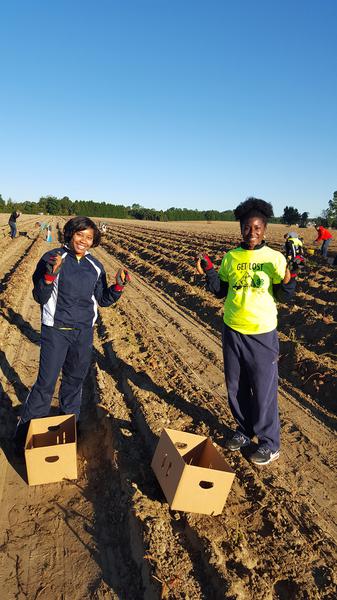General Information
Gleaning is the practice of collecting produce left in the field after farmers harvest for market. The fruits and vegetables left behind are often referred to as “seconds” because they are not desirable at the retail level based on size or other aesthetics; however, they can still be highly nutritious and safe to eat when handled properly. With a farmer’s permission, volunteer groups can go into the field to harvest these seconds. As food safety regulations have become stricter, some farmers have become less comfortable with traditional gleaning models. As a result, some food banks provide bins so that farmers can “glean as you go,” allowing their crews to gather seconds while they harvest market-ready produce and divide donations into a separate bin. Alternately, some farmers use their crews to glean their own fields at the end of the season. In these two cases, farmers have the potential to be reimbursed by food banks or other organizations for the labor and packaging involved in harvesting seconds, referred to as “pick and pack” costs. However, because food banks are nonprofit organizations that operate under tight budgetary constraints, their preference is always for zero-cost donations.
The Society of St. Andrew (SoSA) is a nonprofit group that organizes gleaning events. During the harvest season, SoSA connects with farmers and alerts volunteers when there’s a gleaning opportunity. Individuals and members of school, faith, and community groups can then sign up for a gleaning event. SoSA covers liability insurance for the volunteers, and the volunteer groups coordinate with SoSA to handle product distribution. SoSA usually assigns a field supervisor to accompany and monitor the gleaning activity, which helps to address many of the concerns farmers have about allowing volunteers on their property. SoSA also tracks all of the poundage of produce collected at each farm and provides a tax donation letter to farmers at the end of the year. SoSA encourages individual counties to establish their own gleaning groups and then work with SoSA to make connections with farmers and provide the liability insurance and tax deduction information.
|
Success Story A successful example of a gleaning project has taken place in Harnett County for the past several years. The 4-H and agriculture agents there coordinate a gleaning day with 4-Hers and a local sweet potato farmer. The agriculture agent works with the farmer to determine which field to glean, when the event takes place, and how to facilitate parking. The 4-H agent works with club members to find local sponsors to cover several costs—for liability insurance for all participants, for boxes for harvesting and packing the potatoes, for lunch, and a T-shirt. The sweet potatoes are donated directly to food pantries within Harnett County, and the Food Bank of Central and Eastern North Carolina sends a tractor trailer to collect the rest of the sweet potatoes and distribute them throughout its network. The program first started with a handful of volunteers and a pickup truck; in 2015, 175 volunteers collected 33,000 pounds of sweet potatoes in just a few hours. In conjunction with this donation, N.C. Cooperative Extension worked with Campbell University students to produce educational materials about how to properly store freshly gleaned sweet potatoes that haven’t been cured, as well as recipes for using them. This helps to ensure that those receiving the sweet potatoes are able to prepare and enjoy them. |
How Cooperative Extension Can Be Involved
- Coordinate with Farmers. Extension agents are ideally situated to help facilitate and establish relationships between farmers and gleaning groups in their county or region. They can give farmers information on the benefits of participating in gleaning or donating their seconds, and they can coordinate with regional food banks or local food pantries. Many farmers may be wary of inviting large groups to their farms, both in terms of liability and because of increased food safety regulations. If farmers are hesitant to allow gleaners in their fields, consider suggesting that these farmers work directly with a food bank or pantry.
- Coordinate Clubs. N.C. Cooperative Extension also can facilitate gleaning by coordinating 4-H clubs or other youth or faith-based groups to participate in gleaning projects that can serve as both an educational and a community service opportunity. Partnering with an organization such as SoSA or working through 4-H is a good way to help address farmers’ concerns by providing liability insurance and supervision to gleaners.
Additional Resources
- Society of St. Andrew
This faith-based, volunteer-driven gleaning network has the mission of salvaging fresh produce from farms for individuals in need. Regional offices are located in eastern, central, and western North Carolina. - N.C. Cooperative Extension publication on gleaning
This publication, co-authored by Campbell University public health students, provides information about gleaned sweet potatoes in North Carolina, including storage and nutritional information, as well as recipes.
Publication date: Nov. 8, 2017
LF-15
Other Publications in Farm to Food Bank Resource Guide for North Carolina Cooperative Extension
The use of brand names in this publication does not imply endorsement by NC State University or N.C. A&T State University of the products or services named nor discrimination against similar products or services not mentioned.
N.C. Cooperative Extension prohibits discrimination and harassment regardless of age, color, disability, family and marital status, gender identity, national origin, political beliefs, race, religion, sex (including pregnancy), sexual orientation and veteran status.


